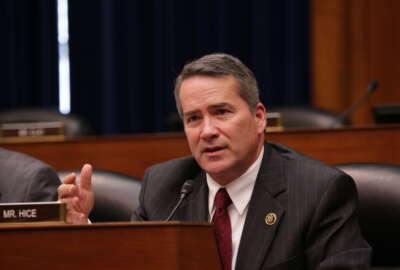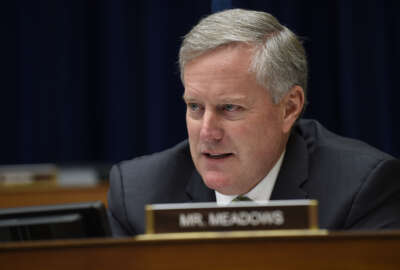
Official time debate takes center stage again with OPM’s latest data
The debate over official time may heat up again, as the Trump administration continues to suggest changes to the current civil service system.
Best listening experience is on Chrome, Firefox or Safari. Subscribe to Federal Drive’s daily audio interviews on Apple Podcasts or PodcastOne.
CORRECTION: The number of hours employees on average spent on official time at individual agencies were incorrectly reported. The story has been updated to reflect the correct data.
Federal employees’ use of official time, or the hours spent performing union work during a normal work day, has ticked up slightly in recent years, according to the latest report from the Office of Personnel Management.
Employees spent a total of 3,611,112 hours on official time in fiscal 2016, slightly more than the 3,468,170 hours bargaining unit employees spent on official time in fiscal 2014, the last time OPM reviewed data on this topic.
Official time cost $174.8 million in 2016, an increase of 7.55 percent over the two-year period, OPM said.
Bargaining unit employees used official time at a rate of 2.95 hours per year in 2016, more than the 2.88 hour rate in 2014.
Several agencies dramatically decreased their employees’ use of official time in 2016.
“Many of the agencies showing the widest variation from the previous reporting year, however, have a small number of bargaining unit employees,” OPM said. “Thus, modest numerical changes in reported hours translate into significant percentage changes for these agencies.”
Twenty-three agencies reported decreases in official time use, while 37 added more to their totals in 2016.
The Health and Human Services Department, for example, increased official time hours by nearly 210 percent between 2014 and 2016.
In contrast, the Commerce Department and Government Publishing Office, for example, saw large decreases in official time usage, dropping by 47.8 percent and 71.9 percent, respectively at those agencies.
Bargaining unit employees at the Homeland Security Department decreased official time by 9.6 percent, while usage fell at the Veterans Affairs Department by 4.1 percent in 2016.
As the second-largest government agency, VA by far spends the most of any other agency on official time — more than $49 million in 2016.
Some lawmakers have criticized the concept of official time, and several have introduced bills in recent years to curb its use or eliminate it completely at some agencies. VA has taken the bulk of the criticism.
House lawmakers introduced specific legislation last year that would limit official time use for some occupations at the department. Though some of these bills have passed in the House, none have made it to the Senate so far.
But lawmakers may be poised to revive a debate over official time in the coming months and years, especially as the Trump administration continues to suggest changes to the current civil service system.
“Taxpayer-funded time, I think, needs to be taken a look at,” OPM Director Jeff Pon told the House Oversight and Government Reform Committee Wednesday during a hearing on the administration’s ideas to modernize the federal workforce. “We can’t just write a report and say how much time is being used by each and every one of the agencies. We need to actively manage it. We need to shed some light on how it’s being used or abused.”
In announcing the release of its 2016 report, OPM pointed to two examples at VA where “problems regarding use of official time have real life impact.” It did not shed light on other specific examples where official time is being used in a more positive way and used the phrase, “taxpayer-funded union time.”
Federal unions have taken notice.
Both the American Federation of Government Employees (AFGE) and the National Federation of Federal Employees (NFFE) called OPM’s report and accompanying press release “misleading.”
In a statement from National Treasury Employees Union President Tony Reardon, the union said official time provides a benefit to both employees and managers. It gives agencies a forum to resolve disputes in a cost-effective, non-confrontational way, he said.
During Wednesday’s hearing, Pon described the Trump administration’s relationship with federal unions as “not so good right now,” but said he wanted to work with them to find areas where they agree. So far, they haven’t found much common ground, Pon added.
House Minority Whip Steny Hoyer (D-Md.) was also critical of OPM’s report.
“The administration is again undermining the right of federal employees to engage in union activities on official time,” Hoyer said in a statement. “Official time is an important tool used to resolve disputes between agencies and their employees and improves the productivity of our workforce.”
Question of accuracy
For its most recent official time review, OPM used the Enterprise Human Resources Integration (EHRI) system to collect data from automated time and attendance systems. It also asked agencies to verify official time hours again, but OPM “has no means of confirming that official time entered by employees working in a representational capacity is a full and accurate representation of official time actually utilized,” the agency said in the report.
Federal law doesn’t require agencies to track official time use and costs, and there’s no governmentwide standard that dictates how agencies should document that information. OPM guidance advises agencies record official time based on five categories.
The Government Accountability Office has criticized the lack of standard reporting and tracking requirements for official time and has questioned the available information’s accuracy and timeliness. GAO made several recommendations on how OPM ultimately shares and tracks agencies’ official time use and measures costs.
OPM, however, said it made no changes to its methodology it used for the 2016 report.
“This administration is passionate about protecting hardworking Americans and the use of their tax dollars,” Pon said Thursday in a statement. “OPM will continue exploring opportunities to identify useful practices for monitoring and reporting on the use of official time and sharing these practices with agencies across the government to assist agencies in strengthening internal controls and increasing transparency, accountability and accuracy.”
Copyright © 2025 Federal News Network. All rights reserved. This website is not intended for users located within the European Economic Area.
Nicole Ogrysko is a reporter for Federal News Network focusing on the federal workforce and federal pay and benefits.
Follow @nogryskoWFED





